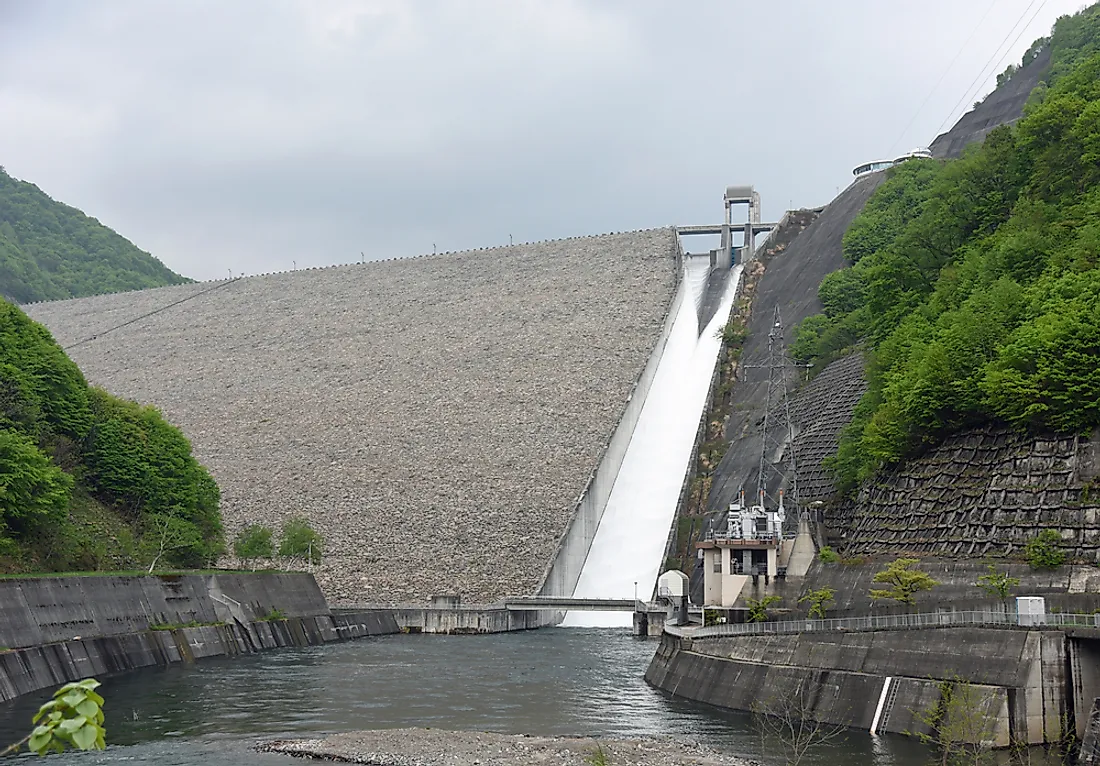The Tallest Dams in Japan

Japan is a country of islands and steep valleys. Dams play a significant role in Japanese society as they are built primarily to control floods, supply water, and generate hydroelectric power. A dam is an embankment built to hold back water and raise its level, framing a store used to produce power or as a water supply. Japan boasts of about 500,000 dams out of which 3,000 are considered “major dams.” The tallest dam in Japan is among the 100 tallest dams in the world at number 54.
The Tallest Dams in Japan
Kurobe Dam
The Kurobe Dam is the tallest dam in Japan at 610 feet high. The dam is built on Kurobe River in Japan’s Toyama Prefecture. Kurobe Dam had a variable-radius arch design and took seven years to build until 1963. The dam has a total capacity of 161,563.121 acre-feet and creates the Kurobe Lake. Japan spent about 51.3 billion yen in the construction that saw the loss of 171 lives as it was a somewhat challenging engineering process. The dam is a huge tourist attraction especially from late June all the way to October. Since its construction, Kurobe Dam has been supporting the Kurobe No. 4 power station which is operated by the Kansai Electric Power Company. The power station generates about 1 billion kilowatt-hours annually.
Takase Dam
Takase Dam is a 577 feet tall dam constructed in a rock-fill dam structure. The dam is the second tallest dam in Japan and the highest of its kind. The dam sits on Shinano River in Nagano Prefecture. The construction of Takase Dam took nine years and ended in 1979. The dam has a total capacity of 61,800 acre-feet and serves as the upper reservoir of the Shin-Takasegawa pumped storage station. Takase Dam is mainly used as a hydroelectric dam and works in combination with another dam, the Nanakura Dam, to generate 1,280 megawatts of power.
Tokuyama Dam
Sitting at 528 feet high, Tokuyama Dam is the third largest dam in Japan. The dam’s construction started in the year 2000 and ended in 2008. Tokuyama Dam has the design of an embankment dam. The dam is built on Ibi River in Japan’s Gifu Prefecture. With a total capacity of 540,000 acre-feet, the dam creates the Tokuyama Reservoir. The dam was built mainly as a hydroelectric dam and also helps to control floods and for water supply. The generation of electricity was expected to begin in 2015 with an installed capacity of 153 megawatts.
Naramata Dam
Naramata Dam is the fourth largest dam in Japan with a height of 518 feet. The dam has a total capacity of 72,964 acre-feet and is built on Naramata River in Gunma Prefecture. The dam supports a power station that produces 12.2 megawatts. With its capacity, the dam creates Lake Naramata. Construction of the dam began in 1973, and the dam was opened for operation in 1990.
Significance of dams
The dams in Japan have played a significant role in controlling floods in most of the deep valleys that the nation possesses. Through the generation of electricity from the many hydroelectric power stations, the nation of Japan has contributed immensely to the growth of the economy and infrastructure. The lakes created by the dams have helped the Japanese population in revenue from fishing and tourism.
The Tallest Dams in Japan
| Rank | Dam | River | Prefecture | Height (m) | Height (ft) |
|---|---|---|---|---|---|
| 1 | Kurobe Dam | Kurobe River | Toyama | 186 | 610 |
| 2 | Takase Dam | Shinano | Nagano | 176 | 577 |
| 3 | Tokuyama Dam | Ibi River | Gifu | 161 | 528 |
| 4 | Naramata Dam | Naramata | Gunma | 158 | 518 |
| 5 | Okutadami Dam | Tadami River | Niigata/Fukushima | 157 | 515 |
| 6 | Miyagase Dam | Nakatsu River | Kanagawa | 156 | 512 |
| 7 | Nukui Dam | Takayama | Hiroshima | 156 | 512 |
| 8 | Urayama | Arakawa River | Saitama | 156 | 512 |
| 9 | Nagawado Dam | Azumi River | Nagano | 155.5 | 510 |
| 10 | Sakuma Dam | Tenryū River | Aichi | 155.5 | 510 |
| 11 | Tedorigawa Dam | Tedori | Ishikawa | 153 | 502 |
| 12 | Tagokura Dam | Tadami River | Fukushima | 145 | 476 |
| 13 | Arimine Dam | Wada River | Toyama | 140 | 460 |
| 14 | Minamiaiki Dam | Minamiaiki | Nagano | 136 | 446 |











